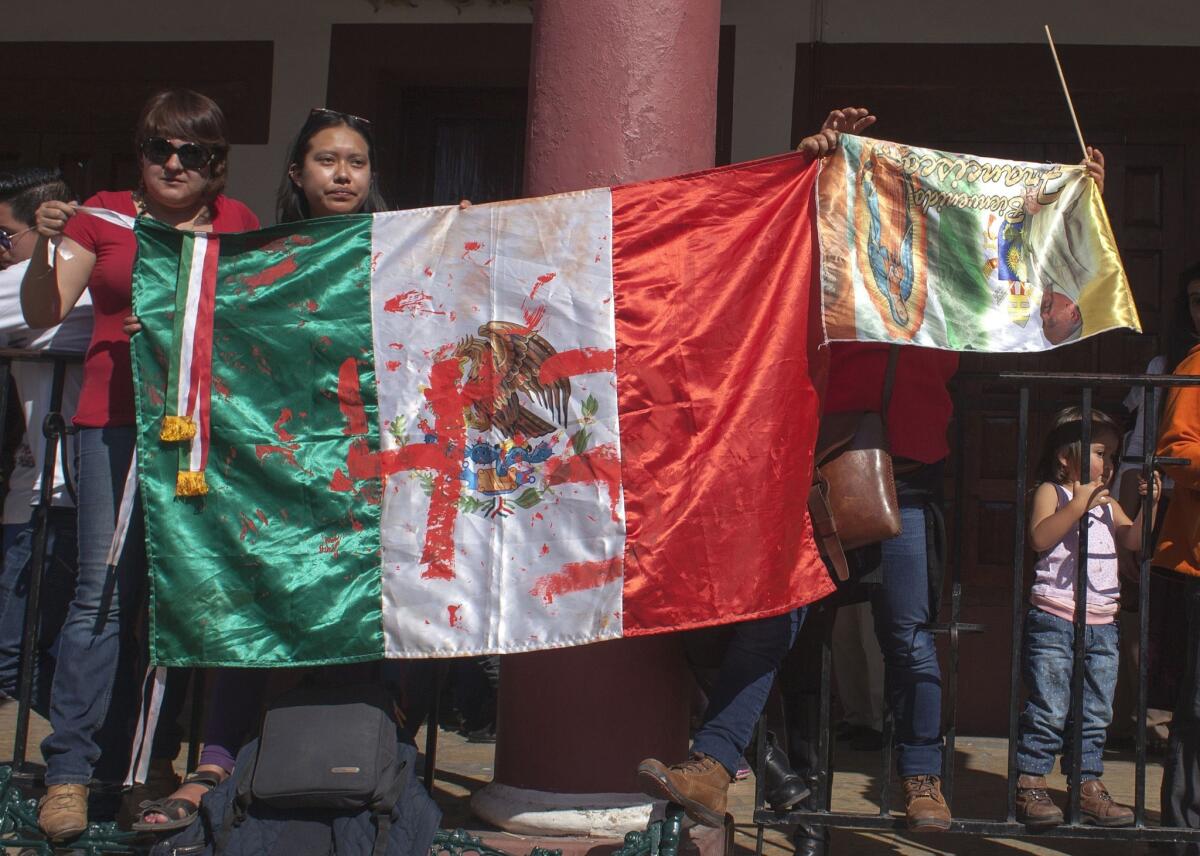Families of missing Mexican students ask: Will Pope Francis speak of ‘los 43’

Activists display a Mexican flag painted to draw attention to the 43 missing students of the Ayotzinapa teachers school. The activists stationed themselves along the route Pope Francis took while in San Cristobal de Las Casas this week.
- Share via
Reporting from Mexico City — In September of 2014, modern Mexican history was severed into two distinct periods: before and after 43 students at a rural teachers college, Escuela Normal Rural de Ayotzinapa, disappeared.
At least, that’s how many Mexicans who identify with the humble families who lost their sons view the event, referred to simply as Ayotzinapa.
On Tuesday, as Pope Francis neared the end of his trip to Mexico, Vatican spokesman Father Federico Lombardi was asked, yet again, why the pope had not addressed “los 43” or their families.
“This is the 20th time I’ve been asked this,” Lombardi said, sighing during a briefing for reporters in Morelia. “I don’t know that I have anything else to add. This is a papal visit ... five days, many different places. He has addressed the theme of migration very clearly and violence.... But he can’t make an encyclopedia of problems.”
Francis has denounced violence and drug trafficking, along with corruption and materialism, since he landed in Mexico on Friday. He has embraced indigenous peoples, saying they’ve been wrongly excluded from society, and he warned Mexico’s bishops to stay on a righteous path. He has spoken of those lost to cartel violence.
But the words “43” or “Ayotzinapa” have yet to cross his lips.
Just as Lombardi was explaining to reporters that Francis “isn’t the solution to all problems,” parents of the students were worrying that the pope would leave Mexico without addressing the 43, and the issue would be misunderstood as a mere subcategory under the umbrella of “violence.”
Or worse, they fear that the same government which they feel impeded a truthful investigation into the disappearance of their children might also be blocking Francis from hearing their voices.
“They’re afraid we’ll tell him the truth of what happened,” said Cristina Bautista Salvador, mother of Benjamin Asencio Bautista, who will be turning 21 on April 9, if he is still alive. “For the Mexican government, it’s like nothing is happening in Mexico, everything is fine.”
The details that are known about the events of Sept. 26, 2014, paint a portrait of horror.
After commandeering five buses that they planned to use as transportation to a demonstration they had planned to attend (a customary practice at the poor and underfunded school), the students were attacked by police. In the coming hours, six people were killed, 20 injured, and the remaining 43 disappeared.
When a search for the missing students began, mass graves were uncovered in the hills of the region. None of the bodies belonged to the students, but the quantity of remains that emerged fomented outrage over the sheer magnitude of the country’s missing.
An investigation by Mexican authorities concluded that the students had been killed by drug traffickers and burned in a fire at a garbage dump in the city of Cocula, about 15 miles from Iguala, where the buses were first attacked.
Just days before Francis landed in Mexico City, the Argentine Forensic Anthropology Team, a group independent of Mexican authorities, disputed the government’s official explanation, concluding through an evaluation of the Cocula site that a fire massive enough to have consumed so many bodies could not have occurred there. The report affirms the conclusion of an earlier inquiry by a group of international experts created by the Inter-American Commission on Human Rights.
Some Mexicans suspect the country’s military was well aware of the events on the night the students disappeared, but did nothing to stop them.
For the families whose children are lost, Ayotzinapa is “an open wound that bleeds every day in this country,” according to their attorney, Vidulfo Rosales. The families hope to deliver a document to Francis with information about their case, even if they don’t get to meet with him in person.
For Meliton Ortega Carlos, whose son Mauricio is among those students, it’s about more than his son or his son’s classmates. Ayotzinapa is symbolic of the larger epidemic of the missing. When he saw the thousands who joined him to march in Mexico City in remembrance one year afterward, he knew that the meaning of the case had not diminished.
“We believe that the objective of the government is that we’ll forget the case once enough time passes,” he said. “We say, ‘Until there is justice we will continue fighting.’”
More than a year after the disappearance, reminders of the students are still written along highways crisscrossing the countryside. “You took them alive, we want them back alive,” some declare. Or, simply, “We’re missing 43.”
At a papal Mass on Tuesday morning at Venustiano Carranza stadium in Morelia, thousands of people raised their voices in an emotional homage to the 43 missing students from Ayotzinapa.
In a video of the scene posted by Mexican media outlets, the crowd counts out the numbers of the victims. “30, 31, 32 …”
Some clergy members appeared to be leading the countdown, cuing the crowd with raised hands. The chanting began before Francis arrived at the stadium, which was filled with priests, bishops, seminarians and thousands of parishioners.
Tillman is a special correspondent. Times staff writers Marisa Gerber and Richard Marosi in Morelia contributed to this report.
More to Read
Sign up for Essential California
The most important California stories and recommendations in your inbox every morning.
You may occasionally receive promotional content from the Los Angeles Times.













